Architecture has always been a reflection of human creativity and ingenuity. Throughout history, iconic buildings have defined the skylines of cities, becoming symbols of progress and innovation. In this blog post, we will explore the top 10 buildings that have redefined modern skylines and left a lasting impact on the architectural world.
1. Burj Khalifa, Dubai

The Burj Khalifa, located in Dubai, United Arab Emirates, is the tallest man-made structure in the world. Here are the full details about this iconic skyscraper:
- Height: The Burj Khalifa stands at an impressive height of 828 meters (2,717 feet) tall, making it the tallest building globally.
- Construction: The construction of the Burj Khalifa began in 2004 and was completed in 2010. It was officially opened on January 4, 2010.
- Architecture: The design of the Burj Khalifa was conceptualized by the architectural firm Skidmore, Owings & Merrill. Adrian Smith was the lead architect. The architecture of the building is inspired by Islamic art and architecture, particularly the patterning prevalent in Islamic culture.
- Purpose: The Burj Khalifa serves multiple purposes, including residential, commercial, and hospitality spaces. It houses luxury apartments, corporate offices, restaurants, observation decks, and a hotel.
- Observation Decks: One of the main attractions of the Burj Khalifa is its observation decks, which offer stunning panoramic views of Dubai and its surroundings. The primary observation deck, known as “At the Top,” is located on the 124th floor. There is also a higher observation deck called “At the Top Sky” on the 148th floor.
- Architecture and Design: The design of the Burj Khalifa incorporates elements of both Islamic and modern architectural styles. The tower features a Y-shaped floor plan, which helps maximize views and structural stability. The exterior of the building is clad in glass and aluminum panels, giving it a sleek and futuristic appearance.
- Construction Materials: The construction of the Burj Khalifa required a vast amount of materials, including concrete, steel, and glass. Over 330,000 cubic meters of concrete and 39,000 tons of steel rebar were used in its construction.
- Records and Achievements: Besides being the tallest building globally, the Burj Khalifa holds several other records, including the tallest freestanding structure, the highest number of stories, the highest occupied floor, and the highest outdoor observation deck.
- Iconic Landmark: The Burj Khalifa has become an iconic symbol of Dubai’s modern skyline and is recognized worldwide as an architectural marvel and a feat of engineering.
- Tourism and Economy: The Burj Khalifa has significantly contributed to Dubai’s tourism and economy by attracting millions of visitors each year and boosting the city’s reputation as a global business and tourism hub.
Overall, the Burj Khalifa stands as a testament to human ingenuity and engineering prowess, representing a fusion of cutting-edge technology, innovative design, and cultural inspiration.
2. Shanghai Tower, China

The Shanghai Tower is a prominent skyscraper located in the Lujiazui area of Pudong, Shanghai, China. Here are the full details about this impressive structure:
- Height: The Shanghai Tower is currently the second-tallest building in the world, standing at a height of 632 meters (2,073 feet).
- Construction: Construction of the Shanghai Tower began in 2008 and was completed in 2015. It officially opened to the public on September 28, 2015.
- Architectural Design: The design of the Shanghai Tower was developed by the architectural firm Gensler. The tower features a distinctive twisting shape, with nine cylindrical sections stacked atop one another. This design is intended to reduce wind loads on the building and improve its structural stability.
- Purpose: The Shanghai Tower serves primarily as a mixed-use building, housing office spaces, retail outlets, hotels, observation decks, and cultural facilities.
- Observation Decks: The tower features observation decks on the 118th, 119th, and 121st floors, offering panoramic views of Shanghai and its surroundings.
- Sustainability: The Shanghai Tower is renowned for its sustainable design features. It has received several green building certifications, including LEED Platinum certification, the highest level of certification awarded by the U.S. Green Building Council.
- Wind Resistance: Given its height and location in a region prone to typhoons, the Shanghai Tower incorporates advanced engineering techniques to withstand high winds and seismic activity. The tower’s twisted form helps to minimize wind loads, while dampers and other structural elements enhance its stability.
- Construction Materials: The Shanghai Tower is primarily constructed of reinforced concrete and steel. Its façade is clad in glass, which provides both structural support and energy efficiency.
- Records and Achievements: In addition to being the second-tallest building globally, the Shanghai Tower holds several other records, including the world’s highest observation deck and the fastest elevators, which can travel at speeds of up to 18 meters per second.
- Impact and Legacy: The Shanghai Tower has become an iconic landmark in Shanghai’s skyline, symbolizing the city’s rapid economic growth and modernization. It has also contributed significantly to the development of the Lujiazui financial district as a global business and tourism hub.
Overall, the Shanghai Tower stands as a remarkable example of innovative architecture, engineering, and sustainable design, showcasing China’s ambition and technological prowess on the world stage.
3. One World Trade Center, New York City
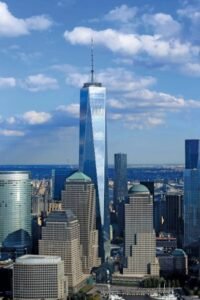
The One World Trade Center (also known as 1 WTC or Freedom Tower) is a prominent skyscraper located in Lower Manhattan, New York City, USA. Here are the full details about this significant structure:
- Height: One World Trade Center stands at a symbolic height of 1,776 feet (541 meters), including its spire, making it the tallest building in the Western Hemisphere.
- Construction: Construction of One World Trade Center began in April 2006, and the building officially opened on November 3, 2014. It serves as the centerpiece of the World Trade Center complex, which was rebuilt after the original complex was destroyed in the September 11, 2001 terrorist attacks.
- Architectural Design: The design of One World Trade Center was developed by the architectural firm Skidmore, Owings & Merrill (SOM). The tower features a sleek, minimalist design with a crystalline form. Its faceted glass exterior reflects the surrounding skyline and changing light conditions.
- Purpose: One World Trade Center is a mixed-use building, housing office spaces, an observation deck, restaurants, and broadcasting facilities. It serves as a symbol of resilience, strength, and renewal following the events of September 11, 2001.
- Observation Deck: The tower’s observation deck, known as the One World Observatory, is located on the 100th, 101st, and 102nd floors. It offers panoramic views of New York City and the surrounding area, including landmarks such as the Statue of Liberty and Central Park.
- Sustainability: One World Trade Center incorporates several sustainable design features, including energy-efficient heating and cooling systems, natural daylighting, and recycled materials. The building has received LEED Gold certification for its environmentally friendly design and operation.
- Safety and Security: Given its location and symbolic significance, One World Trade Center incorporates state-of-the-art safety and security measures. These include blast-resistant construction, redundant emergency systems, and enhanced fire suppression systems.
- Memorial and Museum: Adjacent to One World Trade Center is the National September 11 Memorial & Museum, which honors the victims of the September 11 attacks and documents their history. The memorial features twin reflecting pools located within the footprints of the original Twin Towers.
- Economic Impact: One World Trade Center has had a significant economic impact on Lower Manhattan and New York City as a whole, attracting businesses, tourists, and visitors to the area. It has helped revitalize the World Trade Center site and surrounding neighborhood.
- Symbolism and Legacy: One World Trade Center stands as a powerful symbol of resilience, unity, and hope in the face of adversity. It serves as a testament to the strength and determination of the people of New York City and the United States.
Overall, One World Trade Center represents both a remarkable architectural achievement and a poignant memorial to the events of September 11, 2001, ensuring that the legacy of the World Trade Center endures for future generations.
4. Petronas Towers, Kuala Lumpur
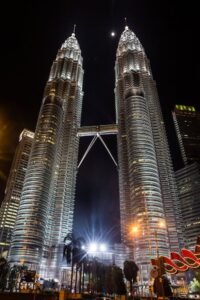
The Petronas Towers, located in Kuala Lumpur, Malaysia, are iconic twin skyscrapers that have become emblematic of the city’s skyline and modern architectural prowess. Here are the full details about these remarkable structures:
- Height: The Petronas Towers were the tallest buildings in the world from 1998 to 2004, standing at a height of 451.9 meters (1,483 feet) each, including their spires. They remain the tallest twin towers globally.
- Construction: Construction of the Petronas Towers began in 1993, and the towers were officially opened on August 31, 1999. They were developed as part of the Kuala Lumpur City Centre (KLCC) project, which aimed to create a new central business district for Kuala Lumpur.
- Architectural Design: The design of the Petronas Towers was the result of an international competition, with the winning design submitted by the Argentine-American architect Cesar Pelli. The towers feature a postmodern architectural style inspired by Islamic geometric patterns, with a sleek and elegant appearance.
- Purpose: The Petronas Towers serve primarily as office buildings, housing the headquarters of the Malaysian national oil company, Petronas, as well as various other businesses and organizations. They also contain a concert hall, a shopping mall, and a skybridge.
- Skybridge: One of the most notable features of the Petronas Towers is the skybridge, which connects the two towers at levels 41 and 42. This double-decker skybridge is the highest two-story bridge in the world and provides stunning views of Kuala Lumpur and the surrounding area.
- Construction Materials: The Petronas Towers are primarily constructed of reinforced concrete, with a steel and glass facade. The facade features over 32,000 stainless steel and glass panels, giving the towers their distinctive appearance.
- Sustainability: Despite being constructed in the late 20th century, the Petronas Towers incorporate several sustainable design features, including energy-efficient lighting systems, water-saving fixtures, and green spaces within the complex.
- Cultural Significance: The Petronas Towers hold significant cultural importance for Malaysia, symbolizing the country’s economic progress, modernization, and ambition on the global stage. They have become a national symbol and a source of pride for Malaysians.
- Tourism: The Petronas Towers are a major tourist attraction in Kuala Lumpur, drawing millions of visitors each year. Tourists can visit the skybridge and observation deck to enjoy panoramic views of the city and learn about the towers’ history and construction.
- Legacy: The Petronas Towers stand as a testament to human ingenuity, engineering excellence, and architectural innovation. They have left an indelible mark on the skyline of Kuala Lumpur and continue to inspire awe and admiration around the world.
Overall, the Petronas Towers are not only architectural marvels but also symbols of Malaysia’s aspirations and achievements in the modern era.
5. Sydney Opera House, Australia
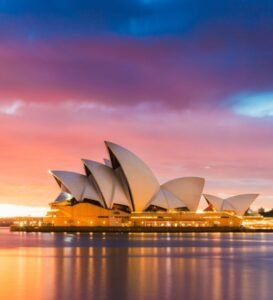
The Sydney Opera House is one of the most iconic and recognizable landmarks in the world, located in Sydney, Australia. Here are the full details about this architectural marvel:
- Location: The Sydney Opera House is situated on Bennelong Point in Sydney Harbour, near the Sydney Harbour Bridge and the central business district of Sydney, Australia.
- Construction: Construction of the Sydney Opera House began in 1959, and the building was officially opened on October 20, 1973. It took 14 years to complete the project, and it involved over 10,000 construction workers.
- Architectural Design: The Sydney Opera House was designed by the Danish architect Jørn Utzon, who won an international design competition for the project in 1957. The design of the Opera House is characterized by its distinctive sail-like shells, which form the roof of the building. The shells are made of precast concrete panels supported by a steel framework.
- Purpose: The Sydney Opera House is a performing arts center that hosts a wide range of cultural events, including opera, theater, ballet, concerts, and other performing arts productions. It serves as a venue for both local and international artists and performers.
- Interior Spaces: The Opera House contains multiple performance venues, including the Concert Hall, which seats up to 2,679 people and is used for orchestral performances and other large-scale productions; the Joan Sutherland Theatre, which seats up to 1,507 people and is primarily used for opera and ballet; the Drama Theatre, the Playhouse, and the Studio, which are smaller venues used for theater, dance, and other performances.
- Architectural Features: In addition to its iconic shells, the Sydney Opera House features other architectural elements, such as its glass curtain walls, which provide natural light and panoramic views of Sydney Harbour; its granite-clad podium, which houses the main foyer and other public spaces; and its elevated platforms and terraces, which create outdoor gathering spaces.
- Cultural Impact: The Sydney Opera House has had a significant cultural impact both locally and internationally. It is a symbol of Australian identity and a UNESCO World Heritage Site, recognized for its architectural significance and cultural importance.
- Tourism: The Sydney Opera House is one of the most popular tourist attractions in Australia, attracting millions of visitors each year. Guided tours are available, allowing visitors to explore the interior spaces of the building, learn about its history and architecture, and enjoy views of Sydney Harbour from its outdoor terraces.
- Renovations and Upgrades: Over the years, the Sydney Opera House has undergone several renovations and upgrades to maintain its structural integrity and modernize its facilities. These renovations have included improvements to acoustics, accessibility, and environmental sustainability.
- Legacy: The Sydney Opera House stands as a symbol of architectural innovation and artistic excellence, representing the creative spirit of its designers, builders, and performers. It is a testament to the power of architecture to inspire, unite, and enrich the lives of people around the world.
6. The Shard, London
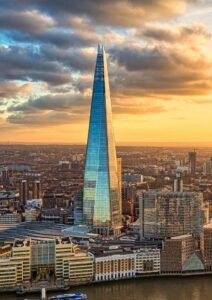
The Shard, also known as the Shard of Glass, Shard London Bridge, or simply the Shard, is a skyscraper located in Southwark, London, United Kingdom. Here are the full details about this impressive structure:
- Height: The Shard stands at a height of 310 meters (1,016 feet), making it the tallest building in the United Kingdom and the European Union as of my last update in January 2022.
- Construction: Construction of the Shard began in March 2009, and the building was completed in March 2012. It was inaugurated on July 5, 2012, and opened to the public shortly thereafter.
- Architectural Design: The Shard was designed by the Italian architect Renzo Piano. Its distinctive shape is characterized by its glass-clad exterior and tapering pyramidal structure, which gives it a sharp, shard-like appearance. The building’s design was inspired by London’s historic church spires and maritime history.
- Purpose: The Shard is a mixed-use development, housing offices, restaurants, a luxury hotel, residential apartments, and a public viewing gallery.
- The View from The Shard: One of the main attractions of the Shard is its observation deck, known as “The View from The Shard.” Located on the building’s 68th to 72nd floors, it offers panoramic views of London and its landmarks, including the River Thames, Tower Bridge, and the London Eye.
- Construction Materials: The Shard is primarily constructed of steel and glass. Its facade consists of over 11,000 glass panels, which cover an area of approximately 56,000 square meters (600,000 square feet).
- Sustainability: The Shard incorporates several sustainable design features, including energy-efficient heating and cooling systems, rainwater harvesting, and natural ventilation. It has received BREEAM (Building Research Establishment Environmental Assessment Method) certification for its environmentally friendly design and operation.
- Landmark Status: The Shard has become an iconic landmark on the London skyline, symbolizing the city’s status as a global financial and cultural hub. Its striking design and prominent location have made it a popular tourist attraction and a focal point for events and celebrations in the city.
- Economic Impact: The Shard has had a significant economic impact on the surrounding area, stimulating development and investment in Southwark and contributing to the revitalization of the London Bridge Quarter.
- Legacy: The Shard stands as a testament to architectural innovation and urban regeneration, representing London’s ongoing transformation and evolution as a modern metropolis. It has become an enduring symbol of the city’s skyline and a source of pride for Londoners and visitors alike.
Overall, the Shard is a landmark achievement in architecture and engineering, showcasing the potential for tall buildings to redefine urban landscapes and create dynamic, vibrant cityscapes.
7. Marina Bay Sands, Singapore

Marina Bay Sands is a world-renowned integrated resort located in Singapore, known for its distinctive architecture, luxurious amenities, and iconic rooftop SkyPark. Here are the full details about this impressive development:
- Location: Marina Bay Sands is situated in the Marina Bay area of Singapore, a prominent waterfront district known for its modern skyline, cultural attractions, and vibrant nightlife.
- Construction: Construction of Marina Bay Sands began in 2006, and the resort officially opened on April 27, 2010. It was developed by Las Vegas Sands Corporation, an American multinational casino and resort company.
- Architecture: The architecture of Marina Bay Sands was designed by the Israeli-Canadian architect Moshe Safdie. The resort features three cascading hotel towers connected by a distinctive rooftop structure known as the SkyPark. The SkyPark spans all three towers and includes observation decks, gardens, swimming pools, restaurants, and bars.
- Hotel: Marina Bay Sands offers luxurious accommodations in its three hotel towers, which collectively house over 2,500 rooms and suites. The hotel rooms are elegantly appointed and feature modern amenities and stunning views of the city skyline or Marina Bay.
- Casino: Marina Bay Sands is home to one of the largest and most renowned casinos in the world, offering a wide range of gaming options, including table games, slot machines, and electronic gaming machines.
- Shopping Mall: The resort features a vast shopping mall known as The Shoppes at Marina Bay Sands, which offers a premium retail experience with over 170 luxury and designer boutiques, as well as restaurants, cafes, and entertainment venues.
- Entertainment: Marina Bay Sands offers a variety of entertainment options, including theaters, nightclubs, bars, and lounges. The resort is also known for hosting world-class entertainment events, concerts, and shows.
- Convention Center: Marina Bay Sands boasts one of the largest and most sophisticated convention and exhibition centers in Asia, with over 1.3 million square feet of flexible event space, including exhibition halls, meeting rooms, and ballrooms.
- Dining: The resort features an extensive selection of dining options, ranging from fine dining restaurants helmed by celebrity chefs to casual eateries offering international cuisine. Visitors can enjoy a diverse culinary experience at Marina Bay Sands.
- Tourism and Landmark Status: Marina Bay Sands has become an iconic landmark and a must-visit destination for tourists visiting Singapore. Its unique architecture, world-class amenities, and stunning views have made it a symbol of the city’s modernity and sophistication.
Overall, Marina Bay Sands offers a luxurious and comprehensive resort experience, combining entertainment, shopping, dining, accommodation, and convention facilities in one spectacular destination. It has played a significant role in shaping Singapore’s tourism landscape and enhancing its global reputation as a premier travel destination.
8. Guggenheim Museum Bilbao, Spain
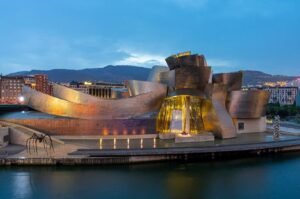
The Guggenheim Museum Bilbao, located in Bilbao, Spain, is a renowned museum of modern and contemporary art known for its innovative architecture and impressive collection. Here are the full details about this iconic institution:
- Location: The Guggenheim Museum Bilbao is situated in the heart of Bilbao, along the Nervion River in the Basque Country region of northern Spain.
- Construction: Construction of the Guggenheim Museum Bilbao began in 1993, and the museum was inaugurated on October 18, 1997. It was designed by the acclaimed architect Frank Gehry, who won an international competition for the project.
- Architecture: The Guggenheim Museum Bilbao is renowned for its groundbreaking architectural design, characterized by its curved and undulating forms, titanium-clad exterior, and futuristic aesthetic. The museum’s unique design has made it an architectural landmark and a symbol of Bilbao’s urban revitalization.
- Purpose: The Guggenheim Museum Bilbao serves as a cultural institution dedicated to modern and contemporary art. It showcases a diverse collection of artworks from the 20th and 21st centuries, including paintings, sculptures, installations, and multimedia works.
- Collection: The museum’s collection includes works by renowned artists such as Pablo Picasso, Mark Rothko, Andy Warhol, Jeff Koons, and Richard Serra, among others. It features both permanent and temporary exhibitions, highlighting various artistic movements and themes.
- Interior Spaces: The Guggenheim Museum Bilbao comprises several galleries and exhibition spaces spread across three floors. The museum’s interior is characterized by its expansive atrium and spiral staircase, which create a dynamic and immersive viewing experience for visitors.
- Outdoor Sculptures: In addition to its interior galleries, the Guggenheim Museum Bilbao features several outdoor sculptures and installations scattered throughout its surrounding grounds, including works by artists such as Louise Bourgeois, Anish Kapoor, and Jeff Koons.
- Educational Programs: The museum offers a range of educational programs and activities for visitors of all ages, including guided tours, workshops, lectures, and outreach initiatives. These programs aim to engage audiences with the museum’s collection and foster a deeper understanding of contemporary art.
- Cultural Impact: The Guggenheim Museum Bilbao has had a transformative impact on the city of Bilbao, contributing to its cultural renaissance and economic revitalization. It has become a major tourist attraction, drawing millions of visitors from around the world each year.
- Legacy: The Guggenheim Museum Bilbao has left a lasting legacy as a pioneering example of architectural innovation and cultural entrepreneurship. It has inspired other cities to invest in cultural infrastructure as a means of driving urban development and promoting tourism.
Overall, the Guggenheim Museum Bilbao stands as a testament to the power of art and architecture to transform cities and enrich the lives of their residents and visitors. It continues to captivate audiences with its stunning architecture, compelling exhibitions, and vibrant cultural programming.
9. Beijing National Stadium, China
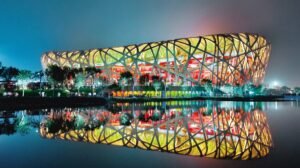
The Beijing National Stadium, also known as the Bird’s Nest due to its distinctive architectural design, is a prominent sports venue located in Beijing, China. Here are the full details about this iconic stadium:
- Location: The Beijing National Stadium is situated in the Olympic Green, an area in the Chaoyang District of Beijing, China.
- Construction: Construction of the Beijing National Stadium began in 2003 in preparation for the 2008 Summer Olympics held in Beijing. The stadium was officially completed in March 2008 and was inaugurated with the opening ceremony of the Olympics on August 8, 2008.
- Architectural Design: The Beijing National Stadium was designed by a consortium of architects, including the Swiss firm Herzog & de Meuron, the Chinese artist Ai Weiwei, and others. The stadium’s design is characterized by its lattice-like steel structure, which resembles a bird’s nest, and its iconic elliptical shape. The stadium’s exterior is covered in a web of interlocking steel beams, giving it a striking and futuristic appearance.
- Purpose: The Beijing National Stadium serves as a multipurpose venue for sporting events, concerts, cultural performances, and other public gatherings. It is primarily known for hosting athletics competitions, including track and field events, as well as football (soccer) matches.
- Capacity: The stadium has a seating capacity of approximately 80,000 spectators, making it one of the largest stadiums in the world.
- Olympic Legacy: The Beijing National Stadium played a central role in the 2008 Summer Olympics, serving as the main venue for the opening and closing ceremonies, as well as numerous athletic competitions. It has since become an enduring symbol of the Olympics and a landmark of Beijing’s urban landscape.
- Sustainability: Despite its large size and complex design, the Beijing National Stadium incorporates several sustainable design features, including rainwater harvesting, natural ventilation systems, and energy-efficient lighting. The stadium’s design also maximizes natural light and airflow, reducing the need for artificial lighting and air conditioning.
- Tourism: The Beijing National Stadium has become a major tourist attraction in Beijing, drawing visitors from around the world who come to admire its architecture and learn about its history. Guided tours of the stadium are available, allowing visitors to explore the interior spaces and learn about its role in hosting the Olympics.
- Cultural Impact: The Beijing National Stadium has had a significant cultural impact, both within China and internationally. It has been featured in numerous films, television programs, and advertisements, cementing its status as an iconic symbol of modern China.
- Legacy: The Beijing National Stadium stands as a testament to China’s ambition, innovation, and technological prowess. It has left a lasting legacy as a landmark of Beijing’s Olympic legacy and a symbol of the country’s emergence as a global superpower.
Overall, the Beijing National Stadium is a remarkable architectural achievement and a source of national pride for China, showcasing the country’s ability to host world-class events and create enduring cultural landmarks.
10. The Louvre Abu Dhabi, United Arab Emirates
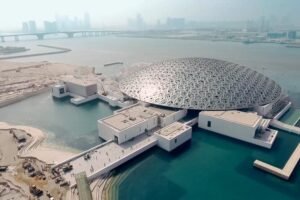
The Louvre Abu Dhabi is a renowned art and civilization museum located in Abu Dhabi, United Arab Emirates. Here are the full details about this cultural institution:
- Location: The Louvre Abu Dhabi is situated on Saadiyat Island, a cultural district in Abu Dhabi dedicated to the arts and culture.
- Construction: Construction of the Louvre Abu Dhabi began in 2009, and the museum was officially inaugurated on November 8, 2017. It was developed as part of a cultural collaboration between the governments of France and the United Arab Emirates.
- Architectural Design: The Louvre Abu Dhabi was designed by the French architect Jean Nouvel. The museum’s design is characterized by its iconic dome-shaped roof, which appears to float above the structure. The dome is made up of eight layers of steel and aluminum, creating a “rain of light” effect that filters sunlight into the museum’s interior.
- Purpose: The Louvre Abu Dhabi is a universal museum that showcases art and artifacts from different cultures and civilizations around the world. It aims to promote cross-cultural understanding and dialogue through its diverse collection and exhibitions.
- Collection: The museum’s collection includes artworks and artifacts spanning thousands of years, from ancient civilizations to the present day. It features pieces from various regions and cultures, including Asia, Africa, Europe, and the Middle East. Highlights of the collection include paintings, sculptures, decorative arts, manuscripts, and archaeological artifacts.
- Exhibition Spaces: The Louvre Abu Dhabi comprises 55 gallery spaces spread across 12 distinct chapters, organized chronologically and thematically. These galleries showcase the museum’s permanent collection, as well as temporary exhibitions curated in collaboration with other institutions around the world.
- Cultural Exchange: The Louvre Abu Dhabi serves as a platform for cultural exchange and collaboration between the UAE and other countries. It has established partnerships with leading cultural institutions, including the Louvre Museum in Paris, France, which lends artworks to the museum for temporary exhibitions.
- Education and Outreach: The museum offers a range of educational programs and activities for visitors of all ages, including guided tours, workshops, lectures, and special events. These programs aim to engage audiences with the museum’s collection and promote a deeper understanding of art and culture.
- Architectural Landmark: The Louvre Abu Dhabi has become an architectural landmark and a symbol of Abu Dhabi’s commitment to the arts and culture. Its striking design and world-class exhibitions have made it a major tourist attraction and a cultural destination for visitors from around the world.
- Legacy: The Louvre Abu Dhabi has left a lasting legacy as a pioneering institution in the region, setting new standards for museum design, curation, and programming. It has helped to elevate Abu Dhabi’s global profile as a center for art and culture and fostered greater appreciation for the arts among its residents and visitors.
Overall, the Louvre Abu Dhabi stands as a testament to the power of art to unite and inspire, transcending boundaries of geography, time, and culture. It continues to enrich the cultural landscape of Abu Dhabi and contribute to the global conversation on art and civilization.
These top 10 buildings represent the pinnacle of modern architecture, pushing the boundaries of design and engineering. They have become symbols of their respective cities, attracting visitors from around the world and leaving a lasting impact on the architectural landscape.



